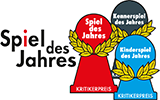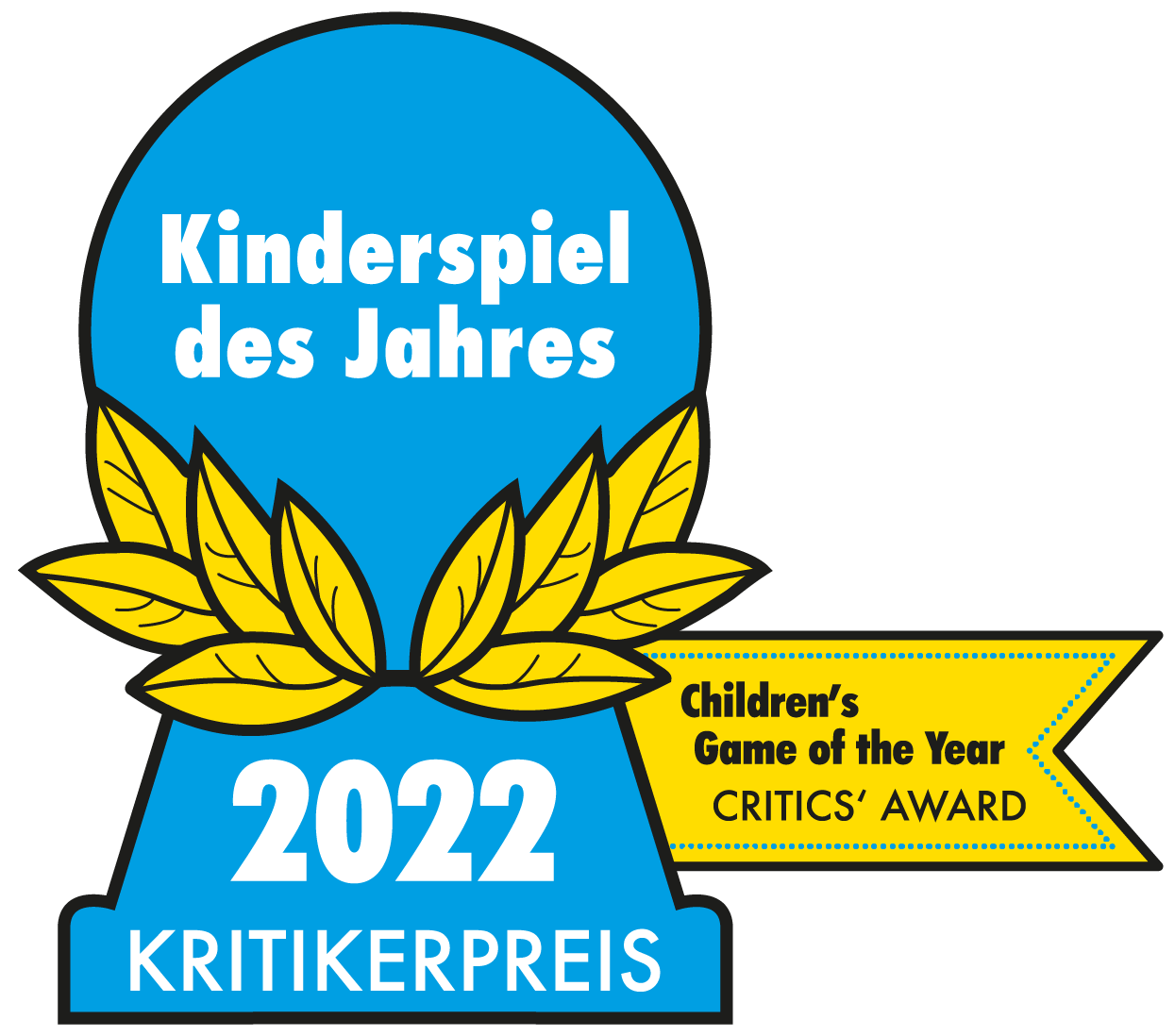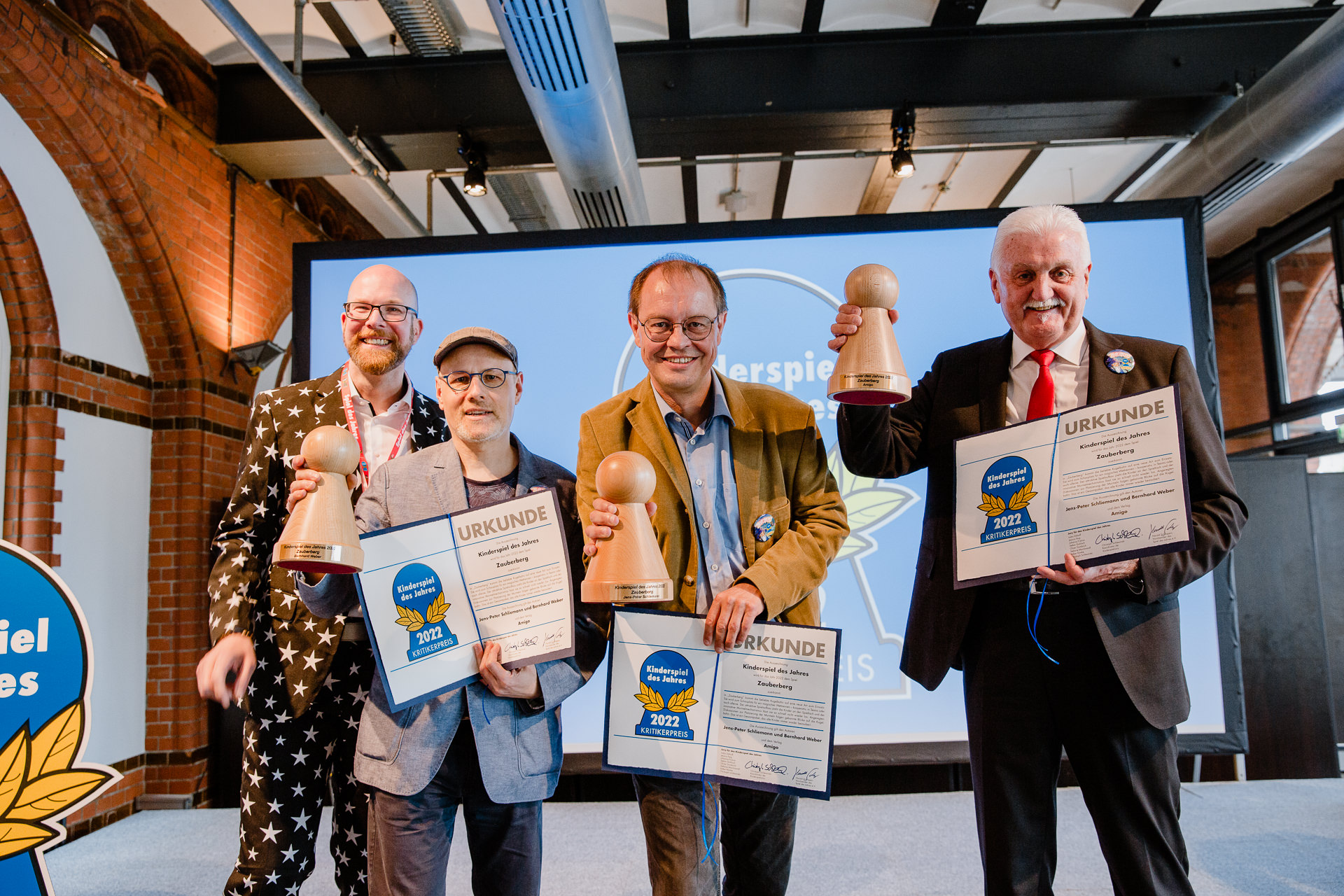Alex Yeager, COO Amigo Games, Talks about the Spiel des Jahres (Game of the Year)
by Amigo | 28 Jul 2022
Industry Commentary, Op-Ed


There are a variety of awards that toys and games can earn, and the purpose and value of those awards can very greatly. But, since 1978, one of the most prestigious – and valuable – awards that board games can win is the Spiel des Jahres (Game of the Year).
The Spiel des Jahres (SdJ) is a juried award, made up of game journalists and critics from a mix of European countries. The goal, from their website, is to reward “games that seem best suited to promote the cultural asset of board games in society.”
This jury currently awards not just one, but three awards:
- The Spiel des Jahres, the “game of the year,” for an entry-level or family game,
- The Kennerspiel des Jahres, the strategy game of the year, for a hobby-level game, and
- The Kinderspiel des Jahres, the children’s game of the year.
The SdJ has been awarded every year since 1979, but the other two awards came later. The Kinderspiel des Jahres was first awarded in 1989, and a variety of special awards for art, design and mechanisms became the Kennerspiel award in 2011. The jury will occasionally award a game for particularly innovative design or presentation, most recently in 2018 for Pandemic Legacy: Season 2.
The jury has always tried to make clear that this is not necessarily the best game, but a game that would be considered the best ambassador for games, out of the year’s releases. Again, from their website, they emphasize that there are a variety of criteria that they use to judge:
“Does it have a completely new concept or does it bring existing elements together to create a new experience? Has the concept been realized in such a way as to engage the player? Does it seem organic and whole or artificial and constructed? Are the rules sensibly constructed, clear, understandable, free of gaps, contradictions and errors? Do the components match their function, are they sturdy and durable? Is the design attractive, do the box, game boards, rules and components complement each other?”
Beyond that, any game that has been released in German within the previous year and is currently available in stores (which excludes small print runs and crowdfunded games without distribution), is eligible for the award. This may seem restrictive, but the speed and success that licenses can be put in place means that the German market, always eager for new and exciting game designs, remains in the forefront for international game releases.
Although the award is German-centric in definition, a wide variety of designers from around the world have won the award. The very first winner, in 1979, was David Parlett from the UK, with Hare and Tortoise, and the winners read like a who’s who of notable designers: Sid Sackson, Alex Randolph, Alan R. Moon, and Reiner Knizia have all been past recipients. The most awarded designer has been Wolfgang Kramer, with five SdJs and a Kinderspiel des Jahres, followed by Catan’s Klaus Teuber with four.
The award has always showcased innovation within the board game design community. For example, Carcassonne brought tile-laying into the mainstream, and Dominion gave us deckbuilding as a new mechanism for designers to explore. The list of SdJ winners also is a time-capsule into what creative and innovative game design looked like during those years.

Unlike many awards, winning one of the awards has an immediate financial impact on publishers. A Kennerspiel or Kinderspiel will see immediate orders in the tens of thousands; for the SdJ, it can venture into the hundreds of thousands. Winners may place SdJ logo onto their games, paying a licensing fee to the jury to financially support the jury’s activities and promotions.
The award also gives these games the chance to attract an audience that spans decades. Many of the winners from the 1980s and 1990s are still in print and remain interesting and fun representatives for board gaming. Games like Scotland Yard, Rummikub, Sherlock Holmes: Consulting Detective, and Catan continue to delight players, and more modern entries like Ticket to Ride, Quirkle and Codenames have become staples on game store shelves.

(Holger Grimm (AMIGO editor), Bernhard Weber and Jens-Peter Schliemann (designers) and Joachim Ulbrich (AMIGO Management)
PHOTO: Children’s Game of the Year / Simona Bednarek CC BY-SA 4.0)
This year, the jury awarded the SdJ to Cascadia, a beautiful game that explores Canada’s lands and animals. Living Forest, the Kennerspiel winner, has players fighting a forest fire, and then planting trees and flowers in its wake. And the 2022 Kinderspiel award went to Magic Mountain, a cooperative game where apprentice witches are racing down a mountain using an inclined marble ramp.
These games join a list of previous award winners that are some of the best games to introduce people to modern board games (and for existing players to enjoy a quality, fun experience). You can explore more information about the awards and the jury behind them at https://www.spiel-des-jahres.de/ (click on the British flag for English). The site and the awards celebrate forty years of innovative and fun game design, with the goal of giving future generations the best possible introduction to board games!
Related Product
Recent Blogs
Recent Blogs

General
McHALE DESIGN CASE STUDY: MONSTERVERSE- THE LEGEND CONTINUES…

General
Build-A-Bear Celebrates National Teddy Bear Day with Donation to The Toy Foundation™

Industry Commentary, Op-Ed
Toy Foundation Auction is Now Open for Your Bids

Industry Commentary, Op-Ed
Bracelets, Stickers, and Viral Fame: The Story Behind Sky Castle Toys’ Sticki Rolls

Biographies and Interviews
Chrissy Fagerholt: Luck is when Preparation Meets Opportunity!
See more
Recent Wiki

BOOK REVIEWS
Book Review: Storm: Dawn of a Goddess by Tiffany D. Jackson

BOOK REVIEWS
Book Review: Erno Rubik and his Magic Cube by Kerry Aradhya

BOOK REVIEWS
Game Review: Trip Chaser

COMPANIES
Learning Express Toys Hosts 25th Annual Convention & Toy Expo at JW Marriott Tucson

MISCELLANEOUS
Submit Your LA Showroom Details for 2025 Toy Previews
See more
POP's Got Talent

POP Entertainment
Randy Klimpert Shares his Ukulele Collection

POP Entertainment
Steve Casino Peanut Art

POP Entertainment
Everyone's Talking about POP!

POP Entertainment
Princess Etch - a Multi-Talented Etch A Sketch Artist

POP Entertainment
Joseph Herscher of Joseph' s Machines.
See more
Recent POPcast

Hidden Role: The Brains Behind your Favorite Games
Connie Vogelmann designed Apiary & Wyrmspan!

Hidden Role: The Brains Behind your Favorite Games
Bob Fuhrer... Is THE Crocodile Dentist!

Hidden Role: The Brains Behind your Favorite Games
Tom Dusenberry... Bought Atari, Wizards of the Coast, and Avalon Hill!

Hidden Role: The Brains Behind your Favorite Games
Matt Leacock created Pandemic... the game!

Hidden Role: The Brains Behind your Favorite Games
Scott Brown and Tim Swindle... are Launching a New Sport!
See more
POPDuos

POPDuos: Interviews with Legends and Leaders
POPDuo: Richard Dickson, Mattel’s President & COO, and Kedar Narayan, Young Inventor Challenge AMB

POPDuos: Interviews with Legends and Leaders
POPDuo: Will Shortz and Josh Wardle

POPDuos: Legends and Leaders Explore Creativity
POP Duo: Elan Lee, Co-Founder, Exploding Kittens.and Jeff Probst, Host and Exec Producer, Survivor

POPDuos: Legends and Leaders Explore Creativity
POP Duo: David Fuhrer, MNG Director, Blue Sq Innovations & Shawn Green, past Dodgers & Mets MLB Star

POPDuos: Legends and Leaders Explore Creativity
POP Duo: Bob Fuhrer, Founder, Nextoy and Tom Fazio, Golf Course Designer
See more














